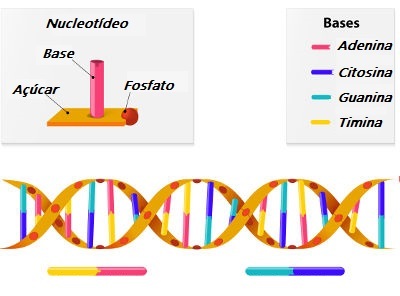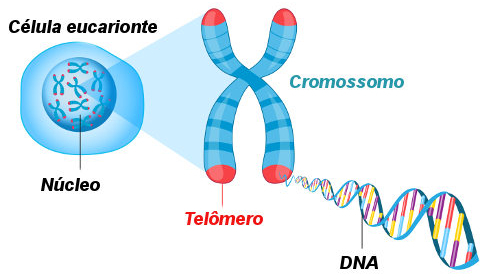We often hear about the DNA (deoxyribonucleic acid), but after all what is this molecule? Discovered in 1869, the DNA molecule is directly related to the physical and physiological characteristics of our bodies and other living beings. In eukaryotic organisms, the DNA molecule is found in the cell nucleus and in organelles called mitochondria. In prokaryotic organisms, this material is present in a dispersed manner in the cell's cytoplasm.
Next, we will describe the main characteristics of the so-called deoxyribonucleic acid.
→ The components of DNA
DNA, like RNA, is a nucleic acid, a structure formed basically by the nucleotide. Nucleotides have three components:
A nitrogenous base;
A sugar;
A phosphate.
In the DNA, the sugar found is a deoxyribose, while nitrogenous bases can be of four types: adenine, guanine, cytosine and thymine. These characteristics allow us to differentiate DNA from RNA, since the sugar present in the RNA it is ribose and in this molecule is found uracil at the thymine site.
→ The structure of DNA
Despite being discovered in 1869, the currently accepted structure of DNA was only proposed in 1953 in a work done by Watson and Crick and published in the journal Nature. This model became known as the double helix and explains that DNA is made up of two long strands that are joined and coiled to form a spiral. Each strand is formed by nucleotides that are linked together through phosphodiester bonds.
Do not stop now... There's more after the advertising ;)

Note the double helix structure of DNA
According to Watson and Crick, theeoxyriboses are more externally related to nitrogenous bases, forming a sort of handrail for a circular staircase. One strand binds to the other through nitrogenous bases that are connected through hydrogen bonds. Considering that the deoxyriboses form the handrail of the stairs, the bases would form the steps.
It is worth noting that nitrogenous bases do not bind randomly. Adenine always binds to thymine through two hydrogen bonds, whereas cytosine binds exclusively to guanine by making three hydrogen bonds.
→ Replication and transcription
DNA is able to duplicate itself in a process called replication. During this process, the DNA molecule opens and a new strand is synthesized on each strand. At the end of the process, two new DNA molecules are formed, each with a new strand and an old strand. Due to this characteristic, it is said that replication is semi-conservative.
DNA is also capable of carrying out the transcription. In this process, the DNA will originate the RNA and for that one of its strands will be used as a template. This process is essential for organisms, since it is the RNA molecule that is responsible for ensuring that the DNA information is translated into proteins .
By Ma. Vanessa dos Santos
Would you like to reference this text in a school or academic work? Look:
SANTOS, Vanessa Sardinha dos. "What is DNA?"; Brazil School. Available in: https://brasilescola.uol.com.br/o-que-e/biologia/o-que-e-dna.htm. Accessed on June 28, 2021.
What is Biology?

Do you know what a chromosome is? Click here and discover what chromosomes are, the material that makes them up and the main parts that make up chromosomes. Also, learn the difference between metacentric, submetacentric, acrocentric and telocentric chromosomes and know how many chromosomes the human species has.
